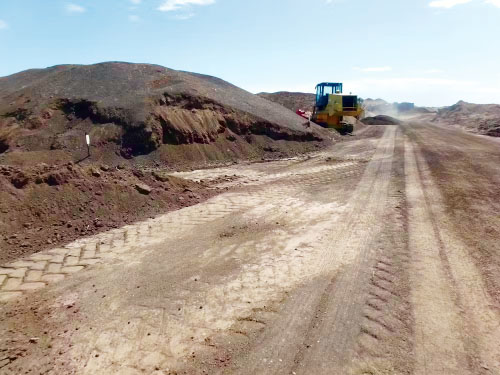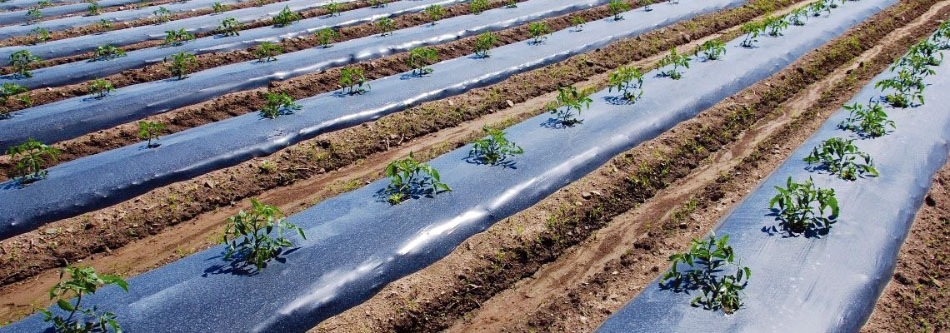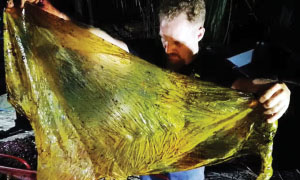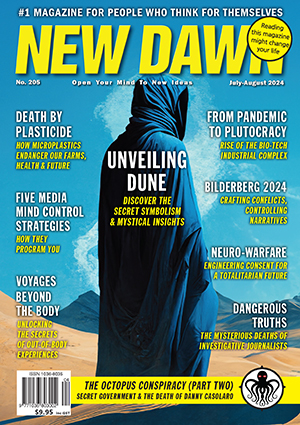From New Dawn 205 (Jul-Aug 2024)
The amount of microplastic I found in the biosolids was really high… and that means they are all going to our agricultural soil.
– Shima Ziajahromi, Griffith University, Australia
Some scientists have estimated the average person might eat 5 grams of microplastics in a week – about the weight of a credit card. Another study breaks that down to up to 52,000 particles annually from various food sources. These figures, which only take into account microplastic particles, are likely underestimated.
– Phoebe Stapleton, PhD, assistant professor of pharmacology and toxicology, Rutgers University
The statistics are staggering. By 2060, humans will produce over one billion tons of plastic waste, much of that in the form of microplastics and nanoplastics – plastic particles smaller than five millimetres long. According to “Human Consumption of Microplastics,” a 2022 research analysis of 26 studies published in Environmental Science & Technology, the average person eats, drinks, and breathes between 78,000 and 211,000 microplastic particles every year – and that is considered a vast underestimation.
Microplastics are found in ever-increasing amounts in our air, water, food, clothing, products, and soil. They pollute our skies, fill our oceans and landfills, and have even been found beneath polar ice and in remote rainforests. We cannot escape them or the detrimental effects they pose to human health. While the global media proclaims climate change as the coming end of humanity, we are slowly being poisoned to death by a far more insidious, immediate threat working its way into our bodies and wreaking havoc with humanity’s future.
A Surprising Source
We once believed that organic soil and fertilisers, and thus, organic farms and the food grown there, were environmentally safe from these tiny plastic particles. However, a new study out of Australia has rung alarm bells within the nation’s agriculture industry and raised public concern.
On 17 May 2024, Sky News investigations reporter Jonathan Lea released the shocking results of a study by researchers at Australia’s Griffith University. Tests revealed that a popular organic fertiliser contained microplastics “full of chemicals that could potentially leach into crops and plants.” Two farms that use the fertiliser were found to have these plastic contaminants in their soil. The research team believes this study proves toxic plastics “are not only being transported to farms but may end up back on our dinner plates,” according to Lea’s report.
The Griffith University study, led by researcher Dr Shima Ziajahromi from the ARI-TOX research group at the Australian Rivers Institute, found thousands of microplastics in small fertiliser samples taken from Queensland, New South Wales, and South Australia. Known as “biosolids,” this type of fertiliser was once considered environmentally friendly because it was made from filtered wastewater from sewage treatment plants. The new study showed much greater amounts of microplastics than expected in the biosolids samples analysed.
Australian wastewater treatment plants produce tonnes of treated sewage sludge annually, which is dried to make these “biosolids.” Two-thirds of the 340,000 tonnes produced annually are used on farms to improve soil quality and stimulate plant growth.
When asked if Australia was unwittingly fertilising its fields and farms with microplastics and chemicals, Dr Ziajahromi answered, “Yes.” The study’s results are a shock to the expanding organic agricultural market and its claims of products that are “green, plentiful, and cheap.” Dr Ziajahromi went on to say, “This is the contamination we (humans) produce and it’s coming back to us.”
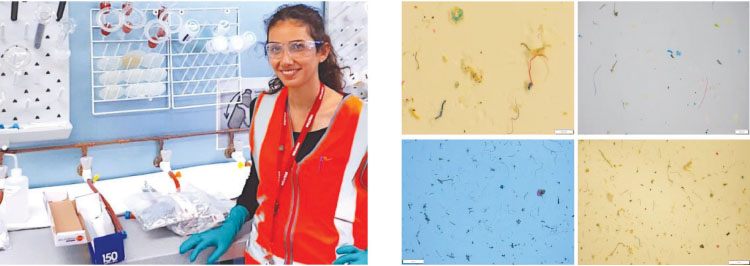
Microplastics get into wastewater via clothing, food containers, and cosmetics washed down through sinks and showers. Because these tiny contaminants do not degrade easily, they have the potential to leach into our soil, which is then consumed by plants and animals and passed down the food chain to humans.
The lack of chemical regulation in Australia is a huge problem, with less than 0.3% of the thousands of chemicals produced daily having regulatory oversight. The call has now gone out to examine Australia’s growing organic farming industry and the need for tighter regulations to protect consumers and farmers who may have used contaminants “by accident” and not with harmful intent. Organic foods Australians consume may not be as healthy as claimed if treated with biosolids filled with microplastics, and consumers deserve to know this.
The Griffith University study was conducted over multiple seasons using a purification method to accurately identify and quantify microplastics (MPs) from complex samples. It revealed that every Australian releases between 0.7 and 2.1g of MPs into wastewater every year, with New South Wales ranking the lowest and South Australia ranking the highest per capita for concentration of MPs.
Current Australian regulations control the amount of heavy metals, nutrients, pathogens, and some emerging contaminants allowed in biosolids, but Dr Ziajahromi said there was currently no guideline for microplastics concentrations.
These findings “underscored the urgent need for a greater understanding of the risks of MPs in biosolids to our agricultural soils as they can accumulate in soils and breakdown into smaller micro and nano-sized particles which can cause more harmful effects to our soil ecosystem.”
The use of plastics expanded after World War 1 and exploded in the 1970s. According to 2022 OECD data, 460 million metric tonnes of plastic is produced worldwide every year – and growing.
We now move to other recent reports about microplastic contamination and the price society and the planet are now paying for this love affair with industrial synthetics.
A Bite of Plastic
A BBC report by Isabelle Gerretsen discusses how microplastics have already infiltrated our food. Plastic pollution, she writes, is “one of the defining legacies of our modern way of life, but it is now so widespread it is even finding its way into fruit and vegetables as they grow.”
MPs are everywhere: buried in the Antarctic sea ice, in the guts of marine animals, in wastewater and drinking water around the world – even on the beaches of the most remote and uninhabited islands.
“One study estimated that there are around 24.4 trillion fragments of microplastics in the upper regions of the world’s oceans,” notes Gerretsen. Microplastics then get into the food we eat. “Unwittingly, we may be consuming tiny fragments of plastic with almost every bite we take.”
A 2022 study by the Environmental Working Group found that sewage sludge had contaminated approximately 20 million acres of US cropland alone. These contaminants are plastic-based “forever chemicals” that do not break down under normal environmental conditions. Europe doesn’t fare any better, as the study showed an estimated 8-10 million tons of sewage sludge produced in Europe each year, with about 40% used on farmlands, which means, according to another study by Cardiff University, between 86 trillion to 710 trillion MP particles could be contaminating European farmland annually.
Another report by the UK’s Environment Agency showed that sewage waste destined for English farmland was contaminated with pollutants, including dioxins and polycyclic aromatic hydrocarbons at levels that may risk human health.
According to a 2020 experiment done by Kansas University agronomist Mary Beth Kirkham, plastic can serve as a vector for plant uptake of toxic chemicals such as cadmium. “In the plants where cadmium was in the soil with plastic, the wheat leaves had much, much more cadmium than the plants that grew without plastic in the soil.”
We might expect MP contaminants in large, industrialised farms and in the food we buy at big supermarkets but they have also been detected in fruits and vegetables sold by local street sellers in Sicily, Italy. Apples appeared to be the most contaminated fruit, with carrots having the highest levels of MPs among vegetable samples. Analysis revealed that the plastics accumulated in the plant roots, meaning that root vegetables such as carrots, turnips, and radishes have more microplastics when consumed.
Even when soil is not as highly contaminated, these persistent chemicals will continue to accumulate until they become a real risk to human health. Numerous studies already show strong negative impacts of microplastics on human health, causing cell damage, infertility, heart disease, cancers, disruptions to the endocrine and thyroid systems, autoimmune disorders, and poor foetal development.
The toxicological impact of MPs is not a conspiracy theory. Solid research abounds, but industry regulators either won’t address this or can’t keep up with the damage already done. One researcher, Willie Peijnenburg, told BBC that, “It will take decades before plastics are fully removed from the environment.”
Sewage Sludge
The Netherlands banned spreading sewage sludge in 1995 and instead exported it to the UK, where it was used as farm fertiliser. Switzerland banned using sewage sludge as fertiliser in 2003 after finding harmful substances and pathogens. In the US, Maine banned the practice in 2023.
However, some people see a total ban on using sewage sludge or biosolids for fertiliser as problematic because the alternative might be even more detrimental to the environment. Instead, there needs to be more research and development into ways of managing the plastic contaminants found in existing biosolids, and there are many great ideas on how to do that if industry cooperates across the board. Countries like Greece and Italy dispose of their sludge in landfill sites but admit that MPs leaching into surrounding lands is still possible.
There are benefits to the use of “municipal biosolids,” which are produced at wastewater treatment plants by the process of settling and stabilising the solid fraction of the municipal wastewater inflow. According to an article in The Conversation, “How microplastics are making their way into our farmland,” municipal biosolids improve agricultural farmland soil because they are rich in nutrients to assist plant growth. Canada carefully regulates their municipal biosolid applications for everything but microplastics. Although wastewater treatment plants are efficient at removing up to 90% of MPs, the removed MPs have to end up somewhere, which is in the concentrated, settled sludge that becomes the biosolids then used to fertilise crops.
“Wastewater treatment plants are well-equipped to remove large plastics like bottle caps and plastic bags from municipal wastewater. However, microplastic particles are so small they can’t be caught by current treatment infrastructure, so they end up concentrating in wastewater sludge,” the article states.
Proposed solutions often involve decreasing the overall use of plastic products, especially single-use plastics like water bottles, which could help minimise the amount of plastic breakdown that gets into wastewater streams and/or into our soil via landfills. New technologies that could be built directly into wastewater treatment facilities could also filter out microplastics through chemical or physical means, although one might again wonder what happens to the stuff that’s filtered out.
An Unavoidable Risk?
The authors of an extensive study, Microplastic Sources, Fate and Solution, say plastic mulch waste is a growing problem that poses challenges for abatement.
“Residues from plastics and plastic elements used in agriculture for crop protection can harm the environment after use if not properly managed, as over time and with exposure to the sun, plastic decomposes into smaller particles that are absorbed by the soil, transported by water or wind, and also ingested by vertebrate and invertebrate animals.”
The study points out that “Mulch film is creating a major environmental problem that is of concern to sector and public administrations. Plastics elimination is both laborious and costly because it is a material composed mainly of low-density polyethylene (LPDE) and takes a long time to biodegrade. It is also often heavily contaminated with soil and plant residues, making it difficult to recycle.”
Farmers use plastic mulch film on numerous crops during the growing season. However, there are no consistently accessible mechanisms for sustainably disposing of plastic mulch film at the end of its life.
According to an article for Modern Farmer, “The use of plastic in agriculture, known as ‘plasticulture’, is expansive. The United States agriculture sector uses one billion pounds of plastic mulch every year. When it comes to disposal, the vast majority of this film gets taken to the landfill or is buried or incinerated.”
“We always talk about this on the student farm – it’s kind of like the dirty secret of organic agriculture and agriculture in general, is just the amount of waste – the amount of single-use plastic,” agricultural teacher Katherine Myrvold told Modern Farmer. “So, that’s something that we’re very open to finding an alternative to.”
Ocean Contamination
MP contamination of the oceans not only impacts the ocean environment itself, but compromises food safety and security and, ultimately, collective human health. MPs are changing the gut microbiomes of seabirds according to a University of Trento, Italy study led by Gloria Fackelmann. She and her colleagues sampled gut microbiomes from two gull-like species in the North Atlantic Ocean. They found high levels of MPs, which makes sense since the world’s oceans have become dumping grounds for plastic waste.
According to Fackelmann, these pollutants congregate in marine environments and are consumed by marine birds, mammals, and fish. Marine biologist Darrell Blatchley found an astonishing 40 kilos of plastic in the gut of a Cuvier’s Beaked Whale that died along the shores of the Philippines. Researchers in Britain found MPs in the guts of over 50 marine animals representing 10 different species.
Spermageddon
For decades, scientists have grappled with the true cause of declining fertility in human populations. The sad reality is that microplastics – which are made up of toxic chemicals – could be directly responsible.
MPs have been called a “significant” potential cause of male infertility, a study published by the US National Library of Medicine says.
A May 2024 study published in Toxicological Sciences found MPs in every human testicle examined, pointing to “potential consequences on male fertility,” according to the authors.
Polyethylene – the type of plastic used in bags and bottles – was the most common type of plastic found, followed by PVC.
“PVC can release a lot of chemicals that interfere with spermatogenesis and it contains chemicals that cause endocrine disruption,” University of New Mexico professor Xiaozhong Yu, one of the study’s co-authors, told The Guardian.
“At the beginning, I doubted whether microplastics could penetrate the reproductive system,” Yu told the outlet. “When I first received the results for dogs I was surprised. I was even more surprised when I received the results for humans.”
The human testicle samples had nearly three times the amount of MPs as the canine samples. The samples were taken in 2016 from men ranging in age from 16 to 88 – and since time has passed, Yu told The Guardian, “The impact on the younger generation might be more concerning” now, given the proliferation of plastic pollution.
Another study published in Environmental Science and Technology Letters showed disturbing amounts of plastic found in baby poop, with evidence showing a higher presence of polyethylene terephthalate in the faeces of infants than in adults. It was even found in the first stool taken from newborn babies. As infants grow, they are exposed to even more plastics via baby bottles.
It would appear no life form can escape this onslaught. Tested samples from remote regions of the Amazon rainforest suggest that plastic pollution travels in atmospheric particles over long distances. There is no such thing as “a pristine zone” on the planet.
A 2023 Newsweek article by Pandora Dewan, “‘Plastic Rainfall’ Contaminating Nearly Everything People Eat and Drink,” explained that 50-75 trillion pieces of microplastics are found in the world’s oceans, many of which end up in our food and waterways.
“With so many of these tiny particles in the ocean, it is perhaps unsurprising that some have been drawn up into the atmosphere. However, their presence in high altitude environments has been largely unstudied – until now.”
Dewan cited a study published in Environmental Chemistry Letters by researchers from Waseda University, Japan. The researchers analysed cloud water from the summits of Mount Fuji and Mount Oyama to investigate whether MPs were found at such high altitudes.
Indeed, that was the case. They were highly fragmented but contained molecules that could bond with water, “suggesting they may play a role in cloud formation, acting as the seed at the centre of the cloud around which water vapour can condense.” The scientific name for this is “cloud condensation nucleus,” and it has the potential, according to the study, to influence global weather patterns.
“Microplastics in the free troposphere are transported and contribute to global pollution,” according to lead researcher Hiroshi Okochi. “If the issue of ‘plastic air pollution’ is not addressed proactively, climate change and ecological risks may become a reality, causing irreversible and serious environmental damage in the future.”
Human Cyborgs & Plastic People
Though there are solutions on the table, it could be years, if not decades, before a viable way to decrease MP exposure becomes a reality. In the meantime, people must do what they can to reduce plastic consumption in their own lives: use quality filters for tap water instead of buying cases of plastic bottled water, seek out local farms that use manure-based fertilisers, research products from salt to clothing to cosmetics that have been tested for MP levels, and vote for policies and programs that take this threat seriously.

Still, it may be too late. According to a new documentary titled “We’re All Plastic People Now,” we may have reached the tipping point of becoming “human cyborgs.” Produced and directed by Rory Fielding, the documentary looks at the devastating impact on marine life from MPs and dives into how plastic pollution is harming human life. Researcher David A. Davis, PhD from the University of Miami, states in the film, “Water is life, so if the water is polluted and we have sentinel species like dolphins and sea turtles, if they’re also sick, we can anticipate that we’ll be sick, too.”
Dr Antonio Ragusa refers to humans as “cyborgs” because the human body is no longer purely biological and has become part plastic.
“When I saw for the first time microplastics in the placenta, I was astonished,” said Dr Ragusa, who is Director of the Department of Obstetrics and Gynecology at San Giovanni Calibita Fatebenefratelli Hospital, Rome, Italy. “It is like having a cyborg baby, no longer composed only of human cells, but a mixture of biological and inorganic entities.”
Producer/director Fielding had four generations of his family’s blood tested for plastic-derived chemicals. The blood was sent to Rolf Halden, PhD, an environmental engineer at Arizona State University, who found Fielding and his family carried over 80 different chemicals in their bodies.
“What we detected in the blood of all these participants are precursors of plastics, plastic constituents themselves, as well as degradation products of consumer plastics. These chemicals are known to be carcinogens, endocrine-disrupting chemicals, obesogens, and neurodegenerative agents.”
Halden emphasised the implications of decreasing sperm counts and loss of fertility, and that “we could be playing with the future of humanity.” Dr Ragusa echoed this concern: “Plastics can be the future for big oil companies. But not for us, not for humanity. For humanity, plastic is the end of the future.”
An Inconvenient Truth
Plastic is all about convenience, making our lives easier in many ways, but that convenience has now become a dire threat to our health – maybe even our survival. People in Australia have had no clue that the organic produce they buy is contaminated with tiny bits of plastic. Knowledge is power, and the people must take back their power and demand change because industry will rarely, if ever, change on its own unless ample profit is involved.
Sources
skynews.com.au/australia-news/fears-for-australias-agricultural-industry-as-concerning-study-finds-large-amount-of-microplastics-in-organic-fertiliser-and-soil/news-story/ac446c5d8c02d78bbb22ac7cf988f707
news.griffith.edu.au/2024/02/21/biosolids-containing-microplastics-used-on-farm-lands/
bbc.com/future/article/20230103-how-plastic-is-getting-into-our-food
Khan, Anish, Chongqing Wang, Abdullah M. Asiri, Editors. Microplastics Sources, Fate and Solution, Springer Nature Singapore, 2023.
nature.com/articles/s41591-024-02968-x
ncbi.nlm.nih.gov/pmc/articles/PMC9134445/
newscientist.com/article/2366045-microplastics-are-changing-the-gut-microbiomes-of-seabirds/
modernfarmer.com/2023/08/plastic-mulch-is-problematic/
newsweek.com/microplastics-found-clouds-1830714
articles.mercola.com/sites/articles/archive/2023/07/27/microplastic-particles-in-human-stool-samples.aspx
articles.mercola.com/sites/articles/archive/2024/05/25/plastic-people.aspx
theconversation.com/how-microplastics-are-making-their-way-into-our-farmland-208346
theguardian.com/environment/article/2024/may/20/microplastics-human-testicles-study-sperm-counts
academic.oup.com/toxsci/advance-article-abstract/doi/10.1093/toxsci/kfae060/7673133
© New Dawn Magazine and the respective author.
For our reproduction notice, click here.



